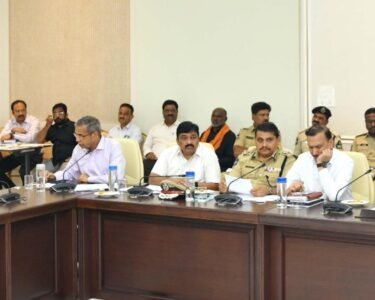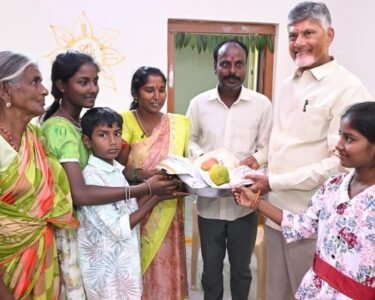At a public meeting in Khammam, the Deputy Chief Minister of Telangana, Mallu Bhatti Vikramarka, reiterated his government’s commitment to putting the welfare of the under-privileged centre-stage. He framed the current administration as one built around the people, not merely on political rhetoric. The remarks underscored how the State government is positioning its welfare agenda as the key differentiator in contrast to the previous regime.
Welfare First: A Core Message
Deputy CM Vikramarka emphasised: “Our objective is to provide a home and restore dignity to every person in the state,” describing welfare schemes as “aimed at eradicating poverty.” He pointed out that his government had made housing for the poor a priority with large-scale spending: “We spent ₹22,000 crore on the Indiramma housing scheme in just one year.” He added that across the state’s 1.1 crore families, nearly 93 lakh families had received some form of welfare benefit within a year-and-a-half of the government’s formation.
Housing for All: The Signature Initiative
One of the flagship initiatives is the Indiramma Housing Scheme, under which the government set out to build large numbers of homes for those without one. Vikramarka claimed that the moment the government came to power, it immediately initiated construction of 4.5 lakh homes.The Deputy CM framed this as part of the government’s broader social contract: ensuring that the most vulnerable are not left out. What distinguishes this narrative is the assertion that welfare is not merely a side project but the very centre of governance.
From Birth to Old Age: Holistic Welfare Coverage
Vikramarka went beyond housing to highlight that welfare measures spanned the entire life-cycle, from newborns to the elderly. “From a newborn child to the elderly, there is a welfare scheme for everyone,” he said.This implies an expansive welfare ecosystem: subsidies, pensions, homes, free power or food, dedicated schemes for women and children. It singles out the government’s approach as not selective but inclusive.
Tackling Past Shortcomings: Contrasting the Previous Regime
A significant portion of the Deputy CM’s speech was devoted to contrasting his government’s performance against the decade-long rule of the previous Bharat Rashtra Samithi-led administration. He accused the former government of “looking after their own interests by converting people’s needs into votes” and said they “failed to solve people’s problems.” He further asserted that had the previous regime built houses for the poor during its ten-year rule, there wouldn’t have been a need to spend thousands of crores now.
Governance with the Poor at the Centre
The underlying theme of Vikramarka’s remarks is that governance must remain anchored in the welfare of the poor. He framed the government’s spending — for example, large allocations for housing, welfare benefits, and other programmes — not as giveaways but as rights of the people. He insisted that conspiracies or opposition manoeuvres would not stop the government from moving ahead with its welfare mission. The New Indian Express
Wider Impact: Social Justice, Inclusion and Public Confidence
Beyond immediate welfare delivery, the government is seeking to build social justice and inclusion into its agenda. By emphasising welfare for every family, and from every stage of life, the message attempts to ensure no one is left behind. This has a dual effect: one, strengthening confidence among historically marginalised communities; two, reinforcing the legitimacy of the government as a people-centred one. The Deputy CM’s statements suggest that welfare is not a side story but a key axis of governance.
Challenges Ahead: Delivery, Scale and Sustainability
While the message is strong, actual delivery remains the proof of the pudding. Large-scale housing and welfare programmes require land, finance, construction capacity, monitoring, transparent delivery and avoidance of leakages. The government will need to ensure that the “for every family” promise is backed by execution. Maintaining fiscal balance while attempting such ambitious programmes is another potential stress point. The previous regime’s debt burden, and the expectation of fast delivery, make the scaling up of welfare both critical and challenging.
Why This Matters for Telangana
For the state of Telangana, which has faced socio-economic pressures including poverty, rural and tribal disadvantage, and urbanisation challenges, a welfare-centric government strategy carries significant promise. By focusing on the homes of the poor, life-cycle welfare, and inclusive coverage, the government is signalling a shift from elite-led development to a model that tries to embed the poor at the heart of governance. If successful, it could reshape the state’s development trajectory and serve as a model for inclusive growth.
Conclusion
Deputy CM Mallu Bhatti Vikramarka’s statement — “ours is a people-centric government, focused on welfare of the poor” — embodies both a declaration of intent and a political commitment. It places the poor, marginalised and vulnerable at the centre of governance, framing welfare not just as policy but as the backbone of the government’s identity. The scale of the promised initiatives — from 4.5 lakh houses to life-cycle welfare benefits — is ambitious. The test ahead lies in translating these commitments into visible outcomes, sustaining them fiscally and administratively, and ensuring that no section of society is left behind. For Telangana, the success of this people-centric model could mark a turning point.







